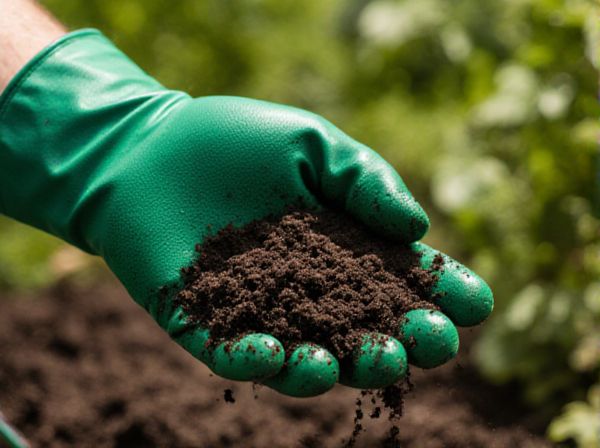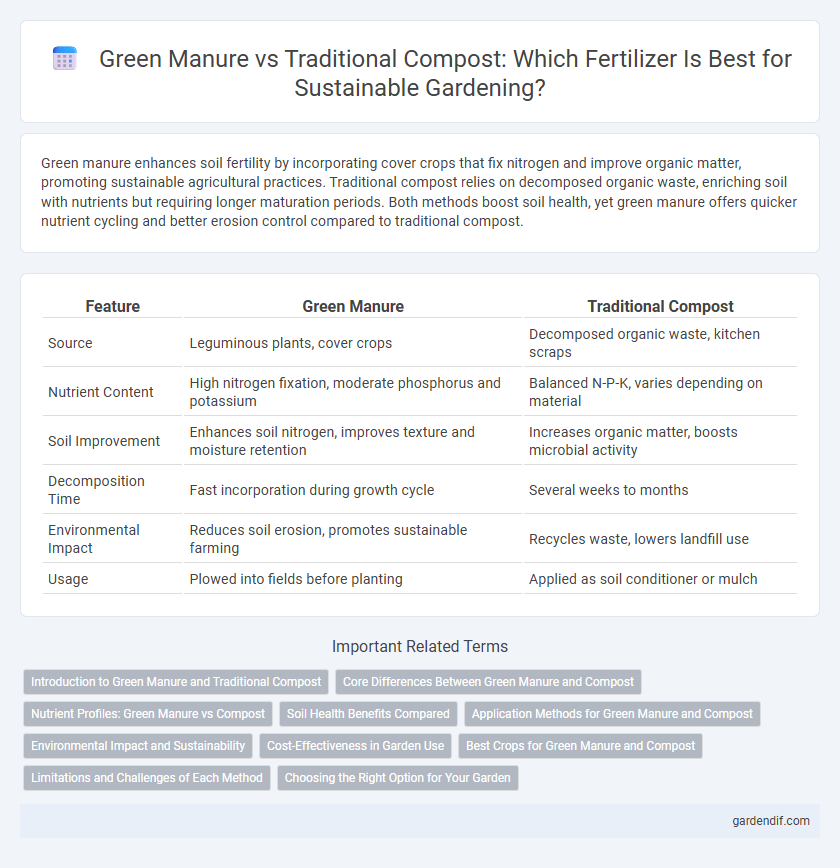
Green manure vs Traditional compost Illustration
Green manure enhances soil fertility by incorporating cover crops that fix nitrogen and improve organic matter, promoting sustainable agricultural practices. Traditional compost relies on decomposed organic waste, enriching soil with nutrients but requiring longer maturation periods. Both methods boost soil health, yet green manure offers quicker nutrient cycling and better erosion control compared to traditional compost.
Table of Comparison
| Feature | Green Manure | Traditional Compost |
|---|---|---|
| Source | Leguminous plants, cover crops | Decomposed organic waste, kitchen scraps |
| Nutrient Content | High nitrogen fixation, moderate phosphorus and potassium | Balanced N-P-K, varies depending on material |
| Soil Improvement | Enhances soil nitrogen, improves texture and moisture retention | Increases organic matter, boosts microbial activity |
| Decomposition Time | Fast incorporation during growth cycle | Several weeks to months |
| Environmental Impact | Reduces soil erosion, promotes sustainable farming | Recycles waste, lowers landfill use |
| Usage | Plowed into fields before planting | Applied as soil conditioner or mulch |
Introduction to Green Manure and Traditional Compost
Green manure consists of specific cover crops grown primarily to enhance soil fertility by fixing nitrogen and adding organic matter, improving soil structure and moisture retention. Traditional compost is composed of decomposed organic waste materials like food scraps, yard waste, and manure, which provide essential nutrients and promote microbial activity in the soil. Both methods enhance soil health but differ in application timing, nutrient release rates, and impact on soil ecosystems.
Core Differences Between Green Manure and Compost
Green manure involves growing specific plants, such as legumes or grasses, which are then incorporated into the soil to enhance nutrient content and organic matter. Traditional compost, on the other hand, consists of decomposed organic waste materials like kitchen scraps and yard clippings, allowing for nutrient recycling through microbial breakdown. The core difference lies in green manure's role as a living cover crop that fixes nitrogen during growth, while compost is a fully processed, nutrient-rich amendment applied to improve soil structure and fertility.
Nutrient Profiles: Green Manure vs Compost
Green manure crops, such as legumes, fix atmospheric nitrogen, enriching soil with high levels of nitrogen, phosphorus, and potassium essential for plant growth. Traditional compost offers a more balanced nutrient profile by decomposing organic matter, incorporating micronutrients and improving soil organic content. While green manure rapidly supplies nitrogen, compost contributes gradual nutrient release and enhances soil structure for long-term fertility.
Soil Health Benefits Compared
Green manure enhances soil health by increasing organic matter content and promoting beneficial microbial activity more rapidly than traditional compost. It aids in nitrogen fixation and improves soil structure, reducing erosion and enhancing water retention. Traditional compost contributes gradually to nutrient availability and long-term soil fertility but lacks the immediate nitrogen enrichment provided by green manure crops.
Application Methods for Green Manure and Compost
Green manure is typically applied by growing specific cover crops such as clover, rye, or vetch directly in the field and then plowing them into the soil to enhance nitrogen content and organic matter. Traditional compost, created from decomposed organic waste like kitchen scraps and garden debris, is spread evenly over the soil surface or incorporated into the topsoil before planting. Both application methods improve soil structure and fertility but differ in timing and the immediate nutrient release, with green manure providing a slow, sustained nutrient supply and compost offering more readily available nutrients.
Environmental Impact and Sustainability
Green manure enhances soil fertility through nitrogen fixation and organic matter addition, reducing the need for synthetic fertilizers and minimizing greenhouse gas emissions. Traditional compost recycles organic waste and improves soil structure but often requires significant energy inputs and can produce methane if not managed properly. Green manure offers greater sustainability by promoting carbon sequestration and supporting biodiversity, whereas traditional compost's environmental impact varies based on feedstock and decomposition methods.
Cost-Effectiveness in Garden Use
Green manure offers a cost-effective solution for garden fertilization by improving soil fertility through nitrogen fixation and organic matter addition, reducing the need for expensive synthetic fertilizers. Traditional compost, while enhancing soil structure and nutrient content, often requires more time and resources to produce, including space and labor for decomposition. Choosing green manure can result in lower overall expenses and sustainable soil health maintenance in small to medium-sized gardens.
Best Crops for Green Manure and Compost
Legumes such as clover, vetch, and alfalfa are the best crops for green manure due to their nitrogen-fixing properties that enhance soil fertility. Traditional compost benefits from a diverse mix of organic waste, including vegetable scraps, grass clippings, and manure, which enriches the soil with a broad spectrum of nutrients. Integrating leguminous green manure with nutrient-rich compost optimizes soil health and boosts crop yields effectively.
Limitations and Challenges of Each Method
Green manure often faces challenges related to crop selection and timing, as its effectiveness depends on appropriate legume species and proper incorporation into the soil before planting. Traditional compost can be limited by lengthy decomposition periods and inconsistent nutrient content, which may affect soil fertility and crop yield uniformity. Both methods require careful management to overcome issues like nitrogen immobilization in green manure and potential pathogen presence in compost.
Choosing the Right Option for Your Garden
Choosing between green manure and traditional compost depends on soil needs and planting schedules; green manure rapidly improves soil structure and nitrogen content by incorporating cover crops directly into the soil. Traditional compost enriches the soil with a broad spectrum of organic nutrients and beneficial microbes, ideal for long-term soil health and nutrient cycling. Gardeners should assess soil fertility goals, crop types, and timing to optimize fertilizer benefits and maximize plant growth.
Green manure vs Traditional compost Infographic

 gardendif.com
gardendif.com